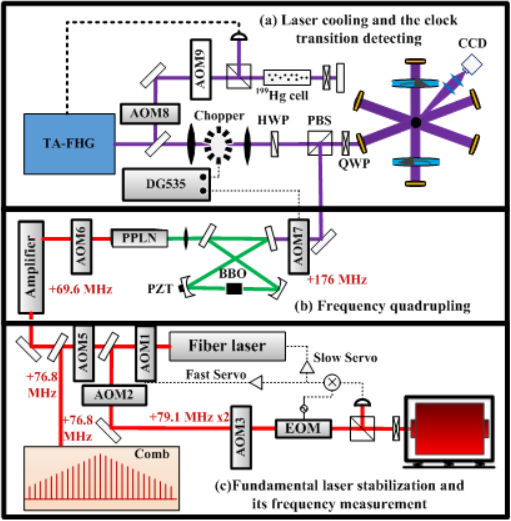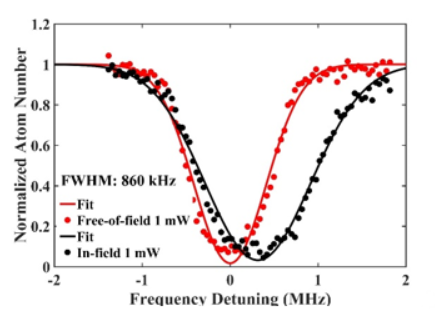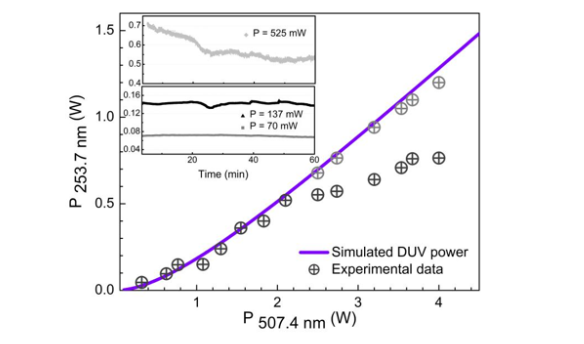
Development of optical clocks based on different elements is of much significance. Frequency ratio measurement between optical clocks with different elements is not only the way towards redefinition of SI second with optical frequency, but also the effective method to test the time invariance of fundamental physical constants such as the fine-structure constant.
Compared with the most accurate optical clock based on Strontium (Sr) atom and the most stable optical clock based on Ytterbium (Yb) atom, mercury atom (Hg) has three advantages: the lowest uncertainty of black-body radiation shift, high saturated vapor pressure at room temperature and simplest magnetic energy levels of the clock transition. Thus it has the possibility to become the next optical clock with 10-18 level uncertainty in normal environment.
The research group led by associate professor XU Zhen in Key Laboratory of Quantum Optics, Shanghai Institute of Optics and Fine Mechanics (SIOM), Chinese Academy of Sciences (CAS), has overcome the challenge of deep-UV laser systems for cooling laser and clock interrogation laser, and observed the spectroscopy of clock transition for 199Hg atom.
To probe the clock transition spectroscopy of 199Hg, the clock laser system at 265.6 nm was designed and built. A 1062.5 nm laser was frequency stabilized to a 10 cm long ULE ultra-stable cavity with drift rate of 50 mHz/s. After a fiber laser amplifier and two stages of frequency doubling, about 10 mW of clock laser at 265.6 nm was generated.
In the magneto-optical trap of Hg atom, the spectroscopy of 1S0-3P0 clock transition is detected in cold 199Hg atoms with this clock laser.
To remove the AC Stark shift of the cooling laser, the spectroscopy is detected by free-of-field detection method. The highest contrast of clock spectroscopy is 95%, the lowest line width is 450 kHz, and absolute frequency of clock transition of 199Hg atom is determined as 1128575290.819(14) MHz.
The results, entitled "Observation of the1S0-3P0 optical clock transition in cold199Hg atoms", were published in Chinese Optics Letters.
To realize more effective laser cooling for Hg atom, a high power continuous wave deep-UV laser system at 253.7 nm was developed. Collaborating with the research group of Professor FENG Yan from SIOM, a room temperature Yb-doped fiber laser amplifier at 1014.8 nm was demonstrated, which can produce 8 W in one stage.
After two cascaded cavity enhanced frequency doubling, which can achieve the doubling efficiencies of maximally 65% and 35% respectively, 1.4 W output deep-UV laser was generated. This laser can be used for realization of 2D MOT and 3D MOT to enhance the loading rate and reduce the quantum projection noise. By four-wave-mixing in mercury atom vapor, it can also be used to generate shorter wavelength deep-UV lasers, such as the Lyman-alpha line at 121 nm.
The results, entitled "High-power continuous-wave narrow-linewidth 253.7 nm deep-ultraviolet laser", were published in Applied Optics.
These two works have put the solid foundation to further realize the neutral mercury optical lattice clock. This work was supported by the Strategic Priority Research Program of the Chinese Academy of Sciences and the National Natural Science Foundation of China (NSFC).

Fig. 1. Experimental setup schematic (Image by SIOM)

Fig. 2. Normalized atom number in the MOT under the in-field (black) and the free-of-field (red) (Image by SIOM)

Fig. 3. Schematic diagram of deep-UV laser system at 253.7 nm (Image by SIOM)

Fig. 4. The output power of 253.7 nm deep-UV laser. (Image by SIOM)

86-10-68597521 (day)
86-10-68597289 (night)

52 Sanlihe Rd., Xicheng District,
Beijing, China (100864)

